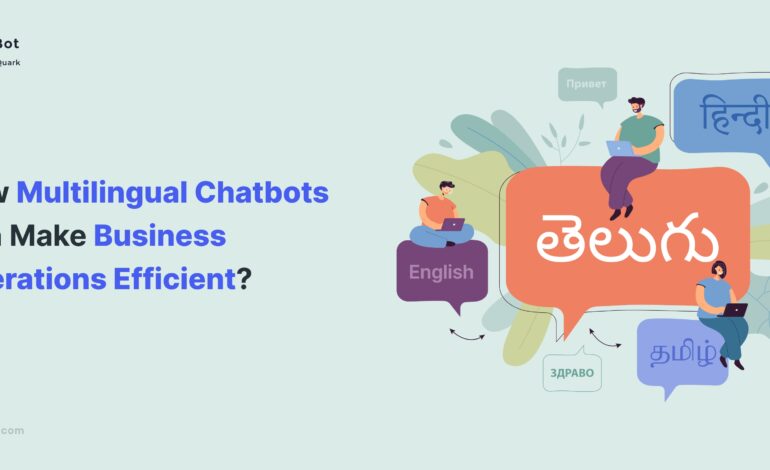How Multilingual Chatbot Can Make Business Operations Efficient?

With the continuous evolution of technology, chatbots have undergone significant transformation. Previously, chatbots were limited to performing tasks predefined by developers. However, with the integration of artificial intelligence, modern chatbots have gained the ability to execute a wide range of tasks, such as handling payments and booking appointments. Among these advancements, multilingual chatbots have emerged as a crucial development
You may be wondering why there is a need for a multilingual chatbot when so many people understand English. However, relying solely on English-centric chatbots could limit the global reach of businesses, as not everyone prefers English as their first language.
According to the stats, 69% of customers prefer chatbots for quick, multilingual conversations with brands. These bots offer a valuable advantage by enhancing the efficiency of business operations. If you are curious to learn how multilingual chatbots can make business operations more efficient, you must read this article.
Moreover, we will also discuss a few other essential aspects that you need to know about multilingual chatbots in this article.
So, without further ado, let’s get started.
We will start with a quick overview of multilingual chatbots.
What is a Multilingual Chatbot?
A multilingual chatbot is an AI-powered virtual assistant with the ability to converse with users in various languages. These bots offer online shoppers live chat and automated support in different languages through messaging apps such as Facebook Messenger or WhatsApp. Integration with websites is also possible, enhancing the overall customer experience.
For brands operating in multiple countries or regions with diverse languages, multilingual chatbots are a must-have. These bots enable businesses to target a larger audience that speaks different languages. Brands can leverage these chatbots for their business operations in the following ways:
- Create a separate chatbot for each language that they support.
- They can also use Google Translate.
- They can also work with an AI chatbot platform like Smatbot which comes with the capabilities of multilingualism.
In short, chatbots have improved themselves with the advancement of AI and NLP. These bots can communicate with users in their preferred languages.
How Do Multilingual Chatbots Work?
Multilingual chatbots employ NLP (Natural Language Processing) and undergo thorough training to comprehend the needs and desires of customers in various scenarios. By discerning the exact needs and requirements of a customer or user, these bots can pose more targeted questions, enhancing their understanding of customer needs more efficiently. This capability is also known as multilingual conversational AI.
Additionally, these bots leverage multilingual AI to provide tailored answers to customer or user queries. Multilingual AI assists these bots in performing a diverse range of tasks in customer-preferred languages.
In essence, these bots can determine the language spoken or understood by a customer or user, enabling them to provide assistance more effectively. For example, if a user interacts in French, the chatbot responds in French throughout the conversation. Similarly, if the next user communicates in English, the chatbot switches to English for the interaction.
Top Reasons For Using A Multilingual Chatbot In Business

As we delve into the efficiency of business operations with multilingual chatbots, it’s crucial to grasp the key reasons for integrating a multilingual chatbot into your business. The improvement of operational efficiency stands out as one of the primary reasons for adopting these bots. Let’s explore additional reasons to incorporate a multilingual chatbot into your business:
- Language hurdle
The language barrier stands out as one of the most significant hurdles preventing businesses or companies from reaching a global audience. Multilingual chatbots possess the ability to discern the preferred language of a user, ensuring a seamless customer experience.
These bots employ language detection techniques, leveraging IP addresses and a comprehension of natural language. This capability ensures that the chatbot communicates in the user’s preferred language.
- Improved conversion rate
Many businesses aspire to enhance their conversion rates, and a multilingual chatbot can play a significant role in achieving this objective. These bots provide users with the flexibility to engage in transactions using their preferred language or the language they use in their day-to-day communication.
This capability greatly contributes to increasing the conversion rate of customers, allowing them to purchase items or products, seek more information, and request support in their mother or native tongue. Failure to incorporate these types of chatbots puts a business at a high risk of losing customers.
- Boost engagement
Multilingual chatbots also possess the ability to enhance customer engagement by creating a better experience for them. Allowing customers to communicate in their preferred language facilitates convenient and quicker access to the information they seek, ultimately resulting in an improved shopping experience.
Imagine a scenario where a customer asks a question in Russian, and your chatbot responds in German or English. This situation implies that customers might have to compromise, and no customer prefers compromise, especially with various businesses available in the market. Such instances indicate that your business is not customer-centric.
To prevent your business from losing customers, it is crucial to eliminate any friction in the customer experience. The optimal way to embark on this journey is to communicate in the terms and preferred language of your customers using these chatbots. Moreover, this approach will streamline the support and sales processes of your business.
- Cost-effective
Certainly, these bots can assist you in targeting an international audience by communicating with them in diverse languages. Alternatively, you can achieve the same goal by hiring a multilingual customer service agent. However, this approach can be more expensive than creating or adopting multilingual chatbots.
The cost-effectiveness of multilingual chatbots is a notable advantage. Yes, you read it right! Multilingual chatbots can also help you save money. These chatbots have the capacity to handle a large volume of inquiries from customers simultaneously, eliminating the need to hire extra staff to handle queries.
- Expand your global reach
Expanding global reach stands out as the most significant reason to use multilingual chatbots. By overcoming language barriers, you can engage potential customers who may not be proficient in the primary language of your business. This increased accessibility comes with the ability to open up streams of new revenue and growth opportunities.
Speaking your customer’s language not only provides a competitive advantage in the international market but also assists in building the loyalty and trust of customers. Additionally, multilingual chatbots can enhance productivity and scalability by offering the same content in diverse languages.
How Multilingual Chatbots Can Make Business Operations Efficient?

Indeed, multilingual chatbots have the potential to improve your company’s operational efficiency in a variety of ways. Below are the top methods by which these bots can make the operation of your business more efficient:
- Increased sales: Multilingual chatbots enhance business operations by boosting overall sales. By overcoming language barriers, these bots ensure clear communication between the audience and the brand. This capability not only increases revenue and sales but also reduces the number of refund requests or dissatisfied customers.
- Better data insight: Multilingual chatbots also come with the ability to analyze and collect data from users, which can help a business gain better insight into the behavior and preferences of the customer. This insight and data can help businesses improve their products and services.
- Personalized service: The best method by which a multilingual chatbot can improve the efficiency of business operations is by providing a personalized experience. Multilingual chatbots can provide personalized solutions to customers based on language preferences.
How Multilingual Chatbots Enhance Customer Satisfaction?
Multilingual chatbots contribute to improved customer satisfaction in various ways. These bots enable businesses to offer personalized support to their customers in their preferred language. Additionally, these chatbots provide accurate and instant responses with the assistance of intelligent virtual assistants, or IVAs.
Personalized interactions with users further enhance customer satisfaction. These interactions eliminate language barriers, allowing customers to initiate conversations in their native language through multilingual chats.
Customers receive friendly responses from these chatbots thanks to intelligent virtual assistants. When customers communicate with these bots, they feel understood and heard, fostering a positive experience and satisfaction without any language constraints.
Tips To Build Multilingual Chatbots
Creating a multilingual chatbot will provide you with the ability to target an international audience. Moreover, these bots will make your business operations more efficient. Let us have a look at the top tips that you can use to build your own multilingual chatbot:
- Determine which languages you want.
Before you begin creating your multilingual chatbot, you should figure out which language you want to add to your chatbot. Furthermore, you should also determine which ‘lingua franca’ you will use that most people will understand. ‘Lingua franca’ is a language or group of different languages used as a medium of communication with individuals whose native languages are different.
The ‘lingua franca’ will be used for your welcome message. So, you should ensure that you familiarize yourself with the region in which your chatbot will be active. If you choose a language that is difficult for your target audience to understand, your customers or users will abandon the conversation before it even begins.
- Use natural language understanding.
The use of natural language understanding or NLU in multilingual chatbots makes the chatbot more effective. You should ensure that you use NLU while creating your chatbot. The use of NLU will provide your chatbot with the capability of more effective localization. For instance, the Microsoft NLU service comes with the ability to differentiate between French spoken in France and French spoken in Canada.
- Align the language with the website.
If you have a website that already allows people to choose their language, then you should include the bot in that language. This method will give the user the freedom to choose their preferred language when they start a chat. The multilingual chatbots can quickly respond in the language that users have selected on your website. This will also give you a sense of accomplishment because the language of your chatbot and website is the same.
Conclusion :
Multilingual chatbots are powerful tools that have provided businesses with the power to target global audiences. The best thing about these chatbots is that they can enhance the customer experience and make your business operations more efficient.
We highly recommend SmatBot if you want to integrate a multilingual chatbot into your business. It supports more than 50 languages and is easy to set up, which makes it an excellent choice for businesses of all sizes.
We hope that our article has helped you understand how multilingual chatbots can improve business operations.




